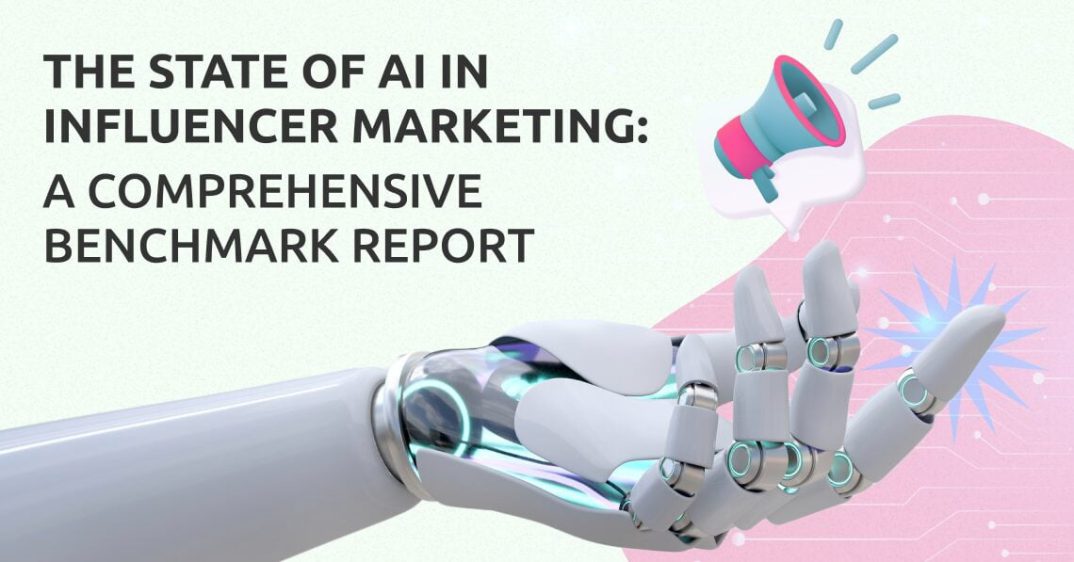The AI Influencer Marketing Benchmark Report 2023 provides an exhaustive analysis of the AI in the influencer marketing landscape, capturing insights from over 500 marketing professionals. It outlines their understanding and applications of AI in influencer marketing, its repercussions for the industry, and their forecasts for its future.
This report goes beyond our annual survey, which collates critical industry data, by incorporating findings from our partners and other pertinent industry reports.
The result is a comprehensive understanding of market dynamics of AI in Influencer Marketing. We are covering two main areas:
- AI technology in Influencer Software Technology
- AI generated Virtual Influencers
Amid the disruptive backdrop of the Covid-19 pandemic, businesses have been pressed to innovate and evolve to navigate economic turmoil and operational hurdles. This necessity for change has further fuelled the digital transformation, making influencer marketing, particularly with AI influencers, an essential tool for brands to foster meaningful connections with consumers.
Notable advancements in the influencer marketing technology landscape include AI’s growing role. For instance, Upfluence, a leading influencer marketing software, recently announced its integration with ChatGPT, a cutting-edge AI language model. This innovative step introduces advanced messaging features set to revolutionize influencer recruitment, making these interactions more efficient and personalized, thus improving overall success rates.
Further, the rise of AI influencers is forging new pathways for brands. Companies like Brud, the creator of virtual influencer Lil Miquela, have shown the immense potential of AI influencers. With a current value exceeding $125 million, Brud is a pioneering figure in the virtual celebrity space. Additionally, venture-backed firms like Shadows, SuperPlastic, and Toonstar are set to introduce their virtual characters on popular social media platforms or their own channels.
These developments emphasize the profound impact of AI on influencer marketing. As we progress, we expect AI to continue molding the industry in unparalleled ways, presenting new opportunities and challenges for marketers.
Yet, in the face of this exciting frontier, it’s easy to dismiss the likes of ‘Nobody Sausage,’ an AI-generated virtual influencer. We urge readers not to judge a book by its cover, or in this case, an influencer by its virtual sausage persona. As strange or amusing as it may seem, the advent of virtual influencers like ‘Nobody Sausage’ signals an unprecedented shift in the influencer marketing landscape. With their rapid rise in popularity and acceptance, there’s a growing consensus that virtual influencers are not just a passing fad but an emerging force poised to reshape the industry.
Key Findings
This section highlights the most significant findings from our research, shedding light on the current landscape of AI in influencer marketing. The key findings include:
- Experience with AI Influencers: 50% of those who have worked with AI influencers described their experience as “very positive”.
- Customizing AI Influencer Behavior: A majority of participants find the ability to customize or control the AI influencer’s behavior and content output either “very important” (42.6%) or “extremely important” (33.5%).
- Future of AI Influencers: 40.9% of participants believe advancements in AI technologies will revolutionize the industry.
- Advantages of AI Influencers: The main advantage of using AI influencers over traditional human influencers was perceived to be “control over messaging” (31.7%), followed by “24/7 availability” (29.1%).
- Ethical Considerations: 43.8% of the participants expressed high concern about the ethical considerations surrounding the use of AI influencers.
- AI Influencers and Purchase Intent: The perceived authenticity of the AI influencer significantly impacts purchase intent for 39.1% of respondents.
- Versatility of AI Influencers: The versatility of AI influencers is perceived as having a significant impact on the future of marketing and entertainment by 52.8% of the respondents.
- AI in Influencer Marketing Technology: Almost half (48.7%) of the participants always apply AI technology in their influencer marketing campaigns.
- AI Technologies Used: Natural language processing (50.4%) is the most commonly used AI technology in influencer marketing efforts.
- AI Impact on Influencer Marketing Outcomes: 37.4% of respondents reported that the application of AI technologies has significantly improved their influencer marketing outcomes.
- AI Influencer Software Priorities: Content generation (46.5%) is the most prioritized capability when choosing AI influencer software.
- Technical Challenges with AI Influencer Software: 77.4% of participants have encountered technical challenges or limitations when working with AI influencer software.
- Desired Improvements in AI Influencer Tools: Better predictive analytics to forecast campaign performance was the most requested improvement (41%).
- Expectations from AI: 41.3% of respondents expect significant improvements from AI in enhancing their influencer marketing efforts.
The State of AI in Influencer Marketing: A Comprehensive Benchmark Report:
Executive Summary
In the executive summary, we provide an overview of the report’s findings, highlighting the most significant trends and insights discovered through our research. This section serves as a quick reference guide for busy professionals, allowing them to grasp the key takeaways at a glance.
Methodology
To ensure accuracy and reliability, this benchmark report is based on a robust methodology, including both primary and secondary research. Our primary research involved a survey conducted on our homepage, where we gathered insights from 500 marketers specializing in AI influencer marketing. The survey included questions related to strategies, challenges, and effectiveness of AI influencer campaigns. In addition to the survey data, we also analyzed industry reports, case studies, and expert opinions to provide a comprehensive analysis.
Survey Demographics
The respondents of our survey consist of 500 marketers who specialize in AI influencer marketing. They come from various backgrounds, encompassing different industries, company sizes, and levels of experience. They all, however, share a common interest and expertise in the emerging field of AI influencers. As part of our commitment to obtaining a well-rounded perspective on the topic, we ensured our respondents include both those who have already implemented AI influencer strategies and those who are considering doing so in the future. This approach allows us to capture a broad range of experiences and expectations, thereby enriching our understanding of the current state of AI influencers in marketing.
- Position in the Organization: Most respondents are at the Junior level (53.3%), followed by Mid-level (13.3%), Owner/CEO/President (10%), Senior level (20%), and Executive level (3.3%).
- Years of Experience in Marketing: A large portion of the respondents have 1-3 years (26.6%) or more than 10 years (36.6%) of experience in marketing. Less than 1 year, 4-6 years, and 7-10 years experience categories each make up 16.6% of respondents.
- Company Size: The majority of the respondents work at companies with 1-10 employees (46.6%), followed by 11-50 employees (20%), more than 500 employees (16.6%), 201-500 employees (13.3%), and 51-200 employees (3.3%).
Part 1 – Artificial Intelligence in Influencer Tech
Industry Trend Analysis
The dawn of the digital era has opened the door to numerous innovations, among which Artificial Intelligence (AI) has emerged as a game-changer. In the realm of marketing, AI’s impact is profound and far-reaching. From our previous AI Marketing Benchmark Report, we learned that marketers are actively leveraging AI in their work, with notable preferences for specific tools. However, nowhere is AI’s impact more apparent than in the field of influencer marketing.
According to our AI Marketing Benchmark Report, a significant proportion of respondents (63%) have indicated plans to incorporate AI or Machine Learning (ML) into their influencer campaigns in 2023. An additional 25% are considering doing so, leaving a relatively small percentage (11.7%) who currently have no intention of using AI or ML in their influencer marketing efforts in the near future. This data signifies the prevalent and growing acceptance of AI tools in influencer marketing strategies, with nearly 90% of respondents seriously contemplating their use. This embrace of AI reflects its transformative potential within the influencer marketing landscape, particularly in the realm of content creation and optimization.
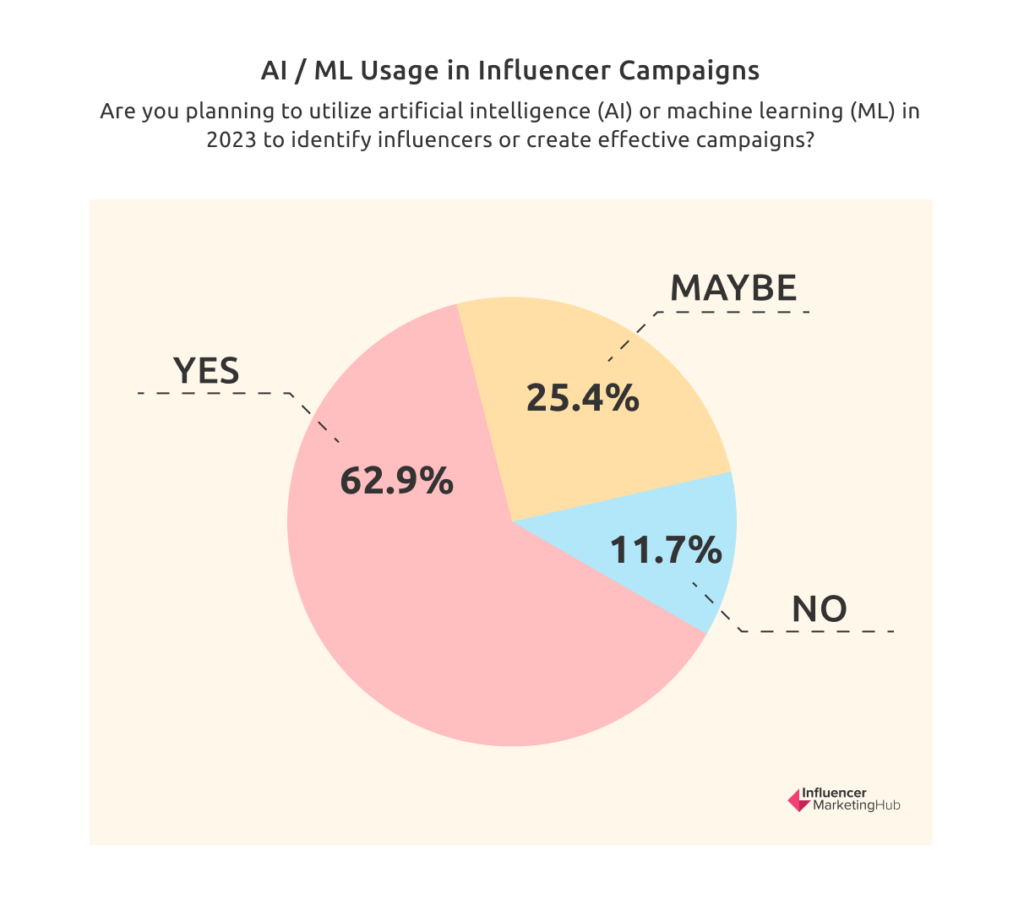
These results underscore the increasingly central role of AI in content marketing. The substantial usage and consideration of AI and ML in influencer campaigns highlight its transformative potential in the influencer marketing landscape, further illustrating the major shift towards data-driven marketing strategies in the industry. As AI and ML technologies continue to improve and become more accessible, we can anticipate a further increase in their usage in influencer marketing and beyond.
AI’s role in influencer marketing has evolved from merely facilitating processes to actively shaping the landscape. Today, it is integral to content creation, audience engagement, data analysis, and even the creation of influencers themselves – AI Influencers. The growing fusion of AI technology and influencer marketing has caught the attention of investors, as evidenced by the impressive funding rounds for companies operating in this space.
In this section, we will examine these industry trends, explore the significant funding figures driving this transformation, and highlight the companies leading this paradigm shift.
Funding in AI Influencer Marketing-related Startups
Looking at AI marketing startups, we see a trend of substantial funding going into companies that utilize AI to optimize marketing efforts. Below is a graph depicting some of the global AI marketing-related startups and their respective funding as of March 2023:
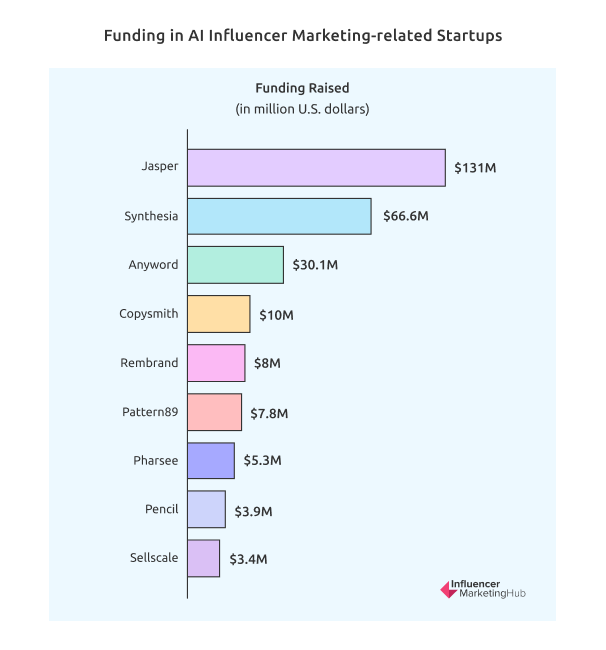
Jasper, which raised the most substantial funding, is streamlining content marketing through its innovative AI-based platform. This company is a prime example of how AI can be harnessed to make content creation more efficient and effective. Synthesia and Anyword, too, are trailblazers, leveraging AI to refine content creation and optimization, enabling more targeted and personalized marketing campaigns.
Marketers’ Perception of AI in the Workplace
Despite the rapid growth and adoption of AI in marketing, there are mixed feelings among marketers about the impact of AI on their job security. According to our AI Marketing Benchmark Report, 35.6% of respondents were concerned that AI might jeopardize their job position, while an equal number did not share this fear. However, most respondents (71.2%) acknowledged that AI can outperform humans in certain tasks.
Interestingly, marketers believed that even if AI takes over many operational tasks, humans will still be in charge of high-level strategy and decision-making (42.2%), as well as creativity and emotional appeals (22.6%). This highlights the continued importance of human ingenuity and strategic thinking in the evolving AI-infused marketing landscape.
Future AI Technology Demand Predictions
As we analyze the realm of influencer marketing, it is essential to understand the intertwining dynamics of the marketers’ current AI technology usage and their future expectations. We start by examining the desired improvements in AI influencer software tools, shedding light on the ongoing evolution of marketers’ needs. The following presentation showcases these demands:
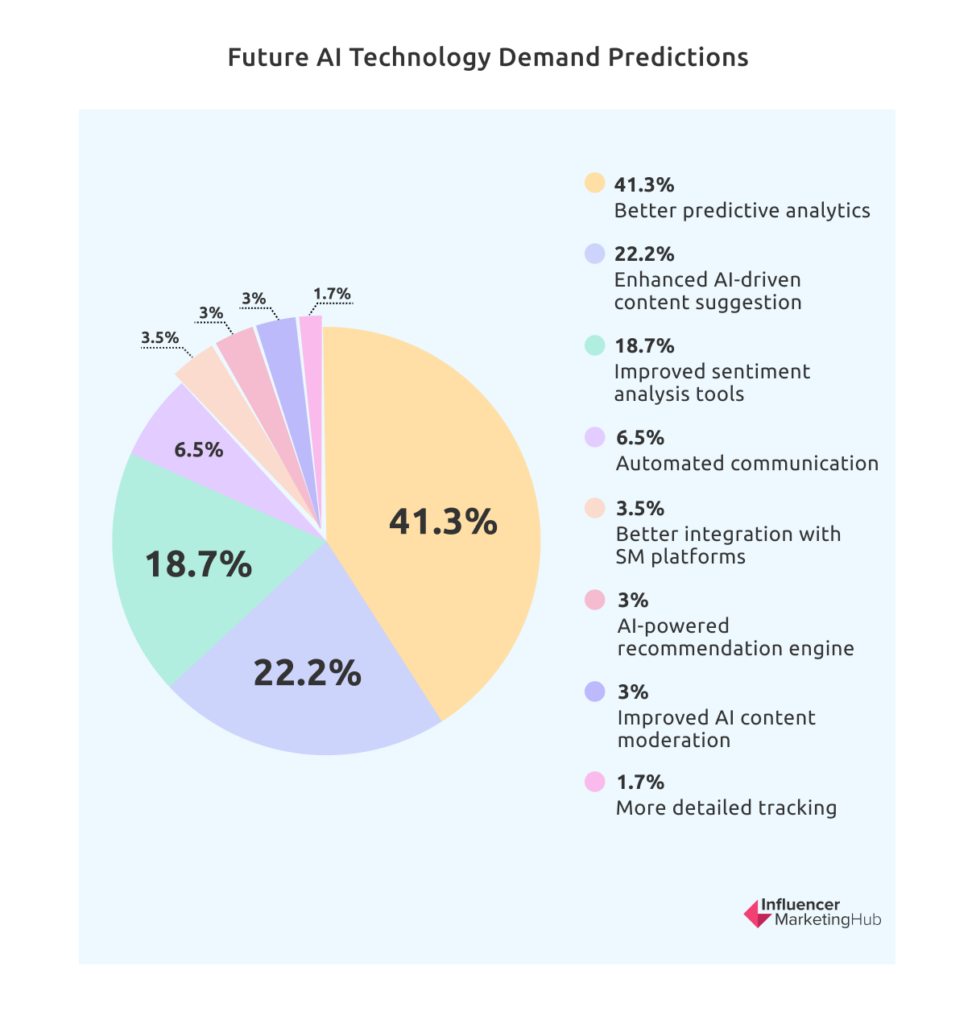
Interestingly, 41.3% of respondents emphasized a demand for better predictive analytics to forecast campaign performance, emphasizing the significant role that accurate predictive models play in their marketing strategies. Furthermore, 22.2% wish for enhanced AI-driven content suggestions tailored to specific audiences. On the other hand, sentiment and engagement analysis tools were in demand by 18.7% of the respondents. Apart from these, the participants highlighted a diverse range of demands like more streamlined communication between brands and influencers (6.5%), better integration with various platforms (3.5%), AI-powered influencer-brand pairing (3%), and improved AI content moderation (3%). A smaller portion (1.7%) expressed the need for detailed tracking of influencer metrics and KPIs. These findings underscore the evolving demands of marketers as they continue to integrate AI into their influencer marketing strategies, suggesting a direction for the development and refinement of AI tools in influencer marketing.
Current Usage of AI Technologies in Influencer Marketing
Transitioning from the future demands to the present, we now examine the AI technologies that marketers currently employ in their influencer marketing efforts. This exploration provides valuable insights into trends and preferences in this rapidly evolving field.
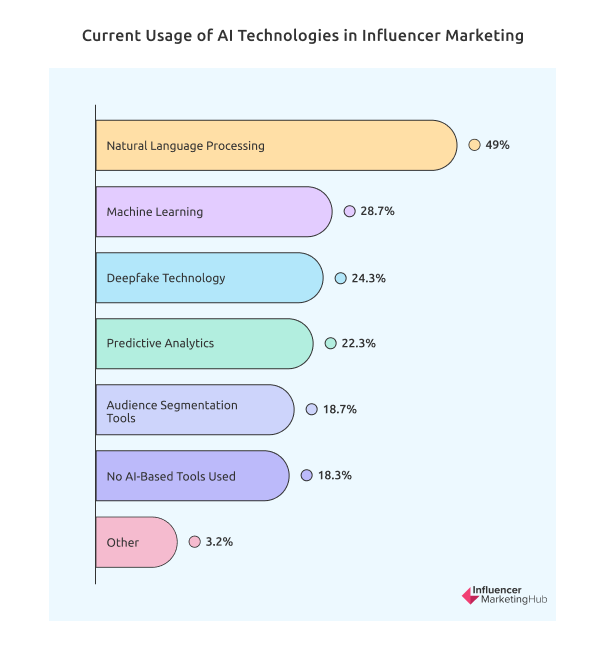
Our survey results illustrate that 49% of respondents currently utilize Natural Language Processing (NLP), signifying its predominance in the field. Machine Learning follows at 28.7%, and Deepfake Technology, enabling the creation of hyper-realistic videos, is employed by 24.3%. In line with the earlier highlighted future demands, a significant proportion of marketers are leveraging Predictive Analytics (22.3%) and Audience Segmentation Tools (18.7%) presently in their strategies. Interestingly, despite the evident advantages of AI, 18.3% of the respondents report not using any AI-based tools in their influencer marketing efforts, indicating a potential area of growth. The correlation between current AI technology usage and future demands offers a comprehensive outlook on the evolving landscape of AI in influencer marketing. As these technologies continue to mature, we can anticipate further alignment and integration, ensuring that marketers’ needs are met and their strategies are enhanced.
Impact of AI Technologies on Influencer Marketing Outcomes
As we venture into the future of influencer marketing, we also turned to our community for their insights on how AI technologies have influenced their influencer marketing outcomes. Their feedback has been invaluable in understanding the opportunities and challenges we face as we move forward.
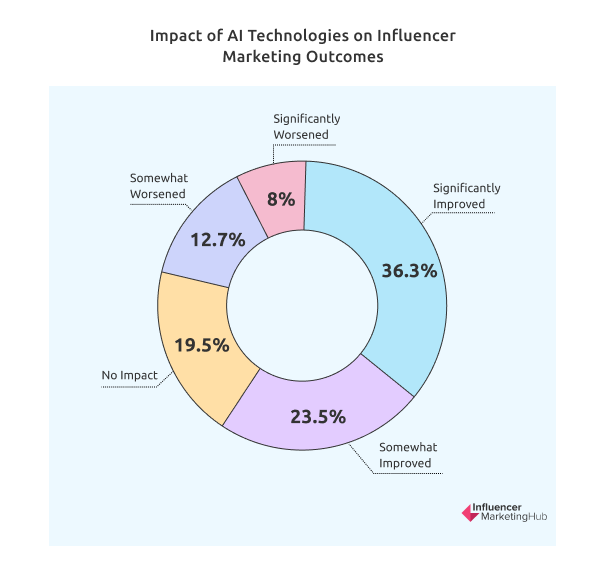
An encouraging 36.3% of the respondents reported that the application of AI technologies had significantly improved their influencer marketing outcomes. This positive sentiment was further supported by an additional 23.5% of respondents who reported a somewhat improved performance due to AI technologies. Conversely, 8% of respondents indicated that their influencer marketing outcomes had significantly worsened with the application of AI technologies, and another 12.7% reported somewhat worse results. Interestingly, there were also 19.5% who experienced no impact from applying AI technologies to their influencer marketing campaigns. This might suggest that the effectiveness of AI technologies can depend significantly on various factors such as the specific use case, the maturity of the AI technology employed, or how it’s integrated into the overall marketing strategy. These findings underscore the potential of AI technologies to enhance influencer marketing outcomes while also emphasizing the need for thoughtful application and consideration of these technologies.
Expectations for AI in Influencer Marketing
As we gain insights into the current impact of AI on influencer marketing, it’s equally important to understand the expectations marketers hold for the future of AI in this field. For this, we surveyed their views on what they expect from AI in enhancing their influencer marketing efforts. Here is a breakdown of the responses:
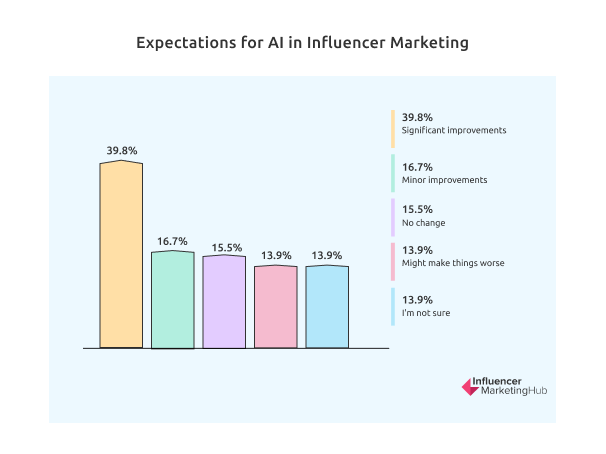
A notable 39.8% of respondents expect significant improvements in their influencer marketing outcomes due to the application of AI technologies. This suggests a high level of optimism and aligns with the 36.3% who have already experienced significant improvements. Meanwhile, 16.7% of respondents expect minor improvements, indicating a more cautious optimism.
At the other end of the spectrum, 13.9% of respondents expect that AI might make their influencer marketing outcomes worse. This corresponds closely to the 12.7% who reported somewhat worse outcomes in the previous section, implying some degree of skepticism or dissatisfaction with current AI applications.
A further 15.5% anticipate no change in their influencer marketing outcomes, mirroring the 19.5% who experienced no impact from current AI applications. Lastly, an equal percentage of respondents (13.9%) indicated uncertainty about their expectations, highlighting the perceived ambiguity and potential unpredictability of AI technologies.
Prioritized Capabilities in AI Influencer Software
After assessing the impact of AI technologies on influencer marketing outcomes, it is crucial to understand the specific capabilities that marketers prioritize when choosing AI influencer software. These capabilities often align with the areas where marketers have seen the most significant improvements due to AI technology. The insights drawn from these preferences can provide direction for software providers to meet evolving market needs effectively.
The graph below illustrates the marketers’ responses to the question: “What capabilities do you prioritize when choosing AI influencer software?”
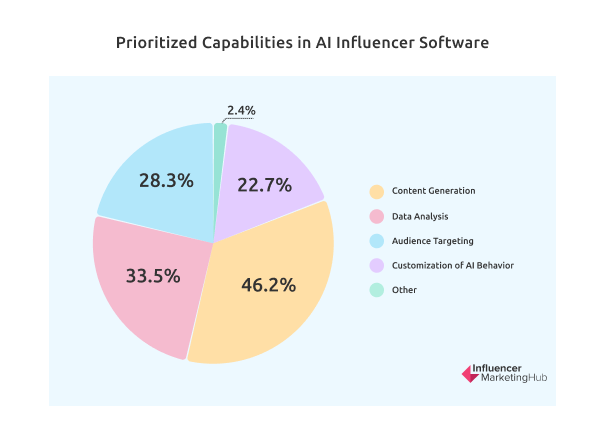
The data highlights that 46.2% of respondents prioritize content generation when selecting AI influencer software. This aligns with the observed significant improvements in influencer marketing outcomes due to AI technologies. Furthermore, it emphasizes the critical role that AI-generated content plays in enhancing campaign performance.
Data analysis and audience targeting are prioritized by 33.5% and 28.3% of respondents, respectively. These capabilities can provide insights into audience behavior and preferences, assisting marketers in devising effective strategies.
Notably, 22.7% of marketers prioritize the customization of AI behavior. This suggests a need for more versatile and adaptable AI tools that can be tailored to suit specific marketing scenarios.
While the majority of marketers prioritize the above-mentioned capabilities, 2.4% indicated other preferences, demonstrating the diverse range of needs and expectations in the market.
This data provides a valuable perspective on the desired features in AI influencer software and highlights areas where software providers can focus their development efforts to satisfy marketers’ evolving needs. It is apparent that an efficient AI tool for influencer marketing should have a mix of these prioritized capabilities to ensure improved outcomes and better user satisfaction.
AI in Marketing Budgets
Our previous report also revealed interesting insights into AI-driven campaign budgets. While 40% of marketers spent less than 10% of their budgets on AI-driven campaigns, nearly 20% allocated more than 40% of their budgets to such initiatives. This spending pattern aligns with the increasing recognition of AI’s potential to enhance marketing efforts, with over 54.5% of respondents believing that AI will greatly improve their marketing outcomes. Meanwhile, 17.1% took a neutral view, asserting that AI would have a moderate impact on marketing. A small portion of respondents, 14%, were uncertain or held a pessimistic view that AI could replace traditional marketing jobs.
This division in perspective reflects the ongoing evolution of the marketing industry in the face of AI’s advancement. Yet, it also reveals a prevailing sense of optimism towards AI’s ability to enhance marketing efforts, a sentiment that’s being corroborated by the increase in funding and investment in AI marketing startups. Notably, our survey found that 71.2% of respondents believe that AI can outperform humans at their jobs. While this may seem alarming at first glance, it’s essential to view it within context. The tasks where AI is considered superior are typically repetitive, data-heavy tasks that can be automated. As such, AI’s increasing role in marketing doesn’t necessarily equate to the replacement of human roles but rather a shift in the nature of those roles. The emerging landscape of AI influencer marketing reveals a compelling dichotomy. On one hand, there’s the transformative potential of AI and the considerable investments fuelling its integration into influencer marketing. On the other hand, there’s the complex human response to AI’s rise, encompassing both excitement about its capabilities and apprehension about its implications.
As AI continues to permeate the influencer marketing industry, its integration is likely to create new opportunities while simultaneously presenting unique challenges. As such, the ability of companies and marketers to adapt to this changing landscape will undoubtedly shape the future of influencer marketing.
In the coming years, it will be crucial for industry players to navigate these complexities and harness the potential of AI to drive innovative, effective, and ethical marketing strategies. As our AI Marketing Benchmark Report has shown, the influence of AI on marketing is far from a mere trend—it’s an evolving reality that is reshaping the marketing industry as we know it.
Part 1 – Conclusion
As we have navigated through the data and perspectives provided by our influencer marketing community, a fascinating, albeit complex, picture of AI’s role in influencer marketing emerges. The integration of AI technologies has led to significant improvements for over 36% of respondents, and a further 23.5% have seen somewhat improved outcomes. These numbers highlight the potential transformative power of AI in influencer marketing, offering the ability to increase efficiency, analyze vast amounts of data, tailor content generation, and enhance audience targeting strategies. It shows us that when AI is effectively utilized, it can yield substantial dividends. However, we must not overlook the 12.7% of respondents whose outcomes have somewhat worsened, or the 8% who have seen significant downturns. These figures are a stark reminder that AI is not a one-size-fits-all solution and that improper or ineffective integration can have adverse effects. It emphasizes the need for careful consideration and a nuanced approach to the application of AI in marketing strategies. Interestingly, 19.5% of respondents have seen no impact from AI applications in their influencer marketing efforts. This may indicate that the effectiveness of AI can vary greatly, depending on its use-case scenario, the level of technology maturity, and its integration within the overall marketing strategy. Looking forward, expectations for AI’s influence on marketing outcomes vary. Nearly 40% of respondents expect significant improvements, reflecting a high level of optimism about AI’s potential. However, a minority believes that AI might make things worse, and others are uncertain. These views underline the need for ongoing dialogue, education, and transparency about AI’s capabilities, limitations, and best practices. In conclusion, the future of AI in influencer marketing is exciting but fraught with complexities. As marketers, it is incumbent upon us to harness the power of AI responsibly, judiciously, and effectively. We need to remain open to its potential, while also mindful of its pitfalls. We should view AI not as a magical solution but as a powerful tool to complement our expertise, creativity, and strategy. AI will inevitably shape the future of influencer marketing; how we adapt, learn and grow with it will ultimately determine our success in this rapidly evolving digital landscape.
Part 2 – Artificial Intelligence Generated Influencers
AI Influencers Insights and Stats
Having delved deeply into the role of AI in marketing and influencer marketing, it is now time to narrow our focus to an intriguing sub-discipline that has been rapidly gaining traction: AI Influencers. These unique entities are not merely supported by AI; they are indeed a creation of the technology. They are a testament to the fusion of artificial intelligence with the art of personality-driven marketing, opening new vistas of possibilities for marketers. AI Influencers are digital personas imbued with artificial intelligence, capable of engaging with audiences and influencing their perceptions and behaviors. They are built to resonate with the audience just as their human counterparts do, sometimes even outperforming them. This hybrid of AI technology and influencer marketing is fascinating, and it carries tremendous implications for the marketing landscape. To understand the impact and potential of AI Influencers, it’s important to take a step back and look at the bigger picture. We must consider a multitude of factors from the macro level, such as their current market presence, audience demographics, engagement rates, geographic reach, and the content preferences they exhibit. Each of these dimensions will give us invaluable insights into the effectiveness and future potential of AI Influencers in reshaping the influencer marketing landscape. Let’s delve into these aspects.
The Rise of AI Influencers: Interest, Usage and Impacts
According to the survey, a substantial 59.8% of respondents have already planned with AI influencers in their marketing campaigns, showcasing the reality and impact of this innovative approach. This indicates a strong endorsement of the potential and efficacy of AI influencers, not merely as a theoretical concept, but as a functioning element within the contemporary marketing toolkit.
Despite this, 24.7% of professionals reported not yet having used AI influencers, offering a glimpse into an untapped market. Encouragingly, 15.5% of respondents are contemplating the use of AI influencers in their future campaigns, illustrating an enduring interest and a fertile ground for growth in this domain.
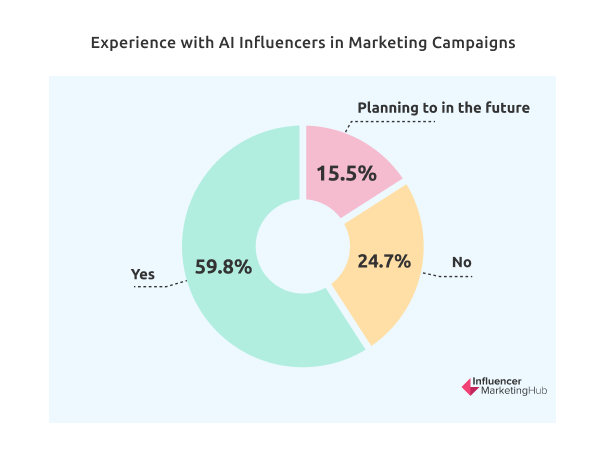
Regarding perceptions of effectiveness, a large proportion (49.3%) of professionals had a very positive view of AI influencers, reflecting high satisfaction levels with their performance in campaigns. A significant group (28%) maintained a neutral stance, indicating room for further exposure and conviction. A total of 16.7% viewed AI influencers in a somewhat or very negative light, suggesting areas for potential improvement and evolution.
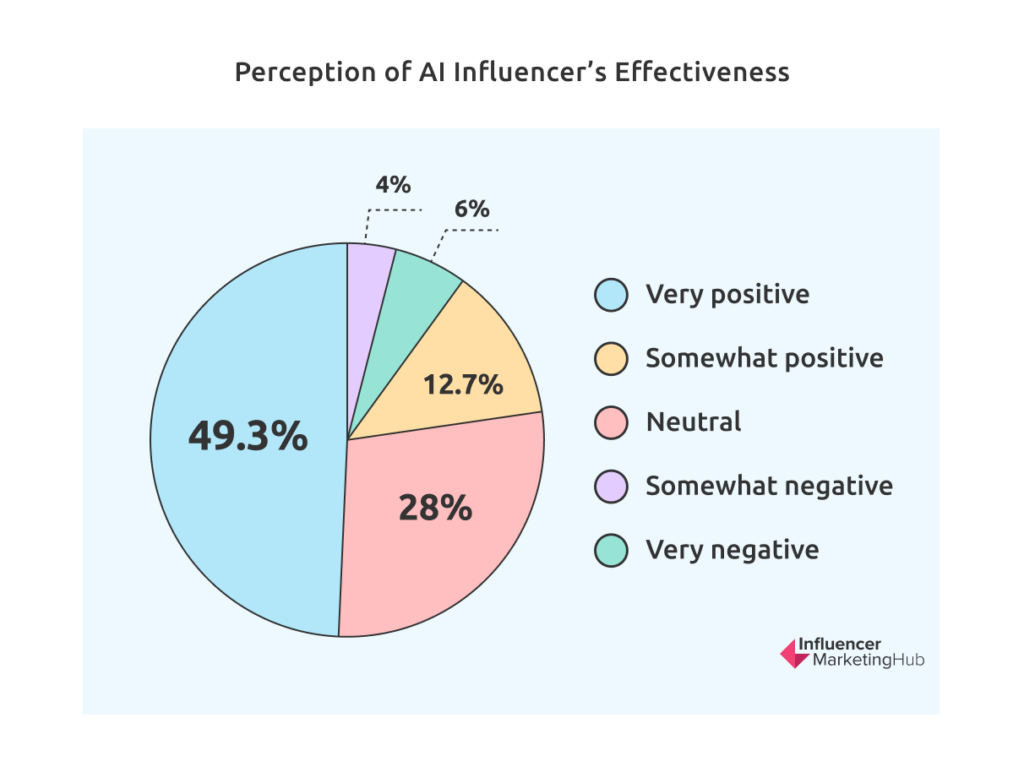
In the broader context of this report, these findings highlight the growing role and acceptance of AI influencers in the marketing landscape. They serve as a strong precursor to discussions on the potentials, challenges, and future directions of AI influencers in shaping marketing strategies.
Follower Dynamics
In the domain of AI influencers, certain profiles have demonstrated remarkable traction. The following table lists the top ten virtual influencers and the fastest growing virtual influencers, measured by their number of followers:
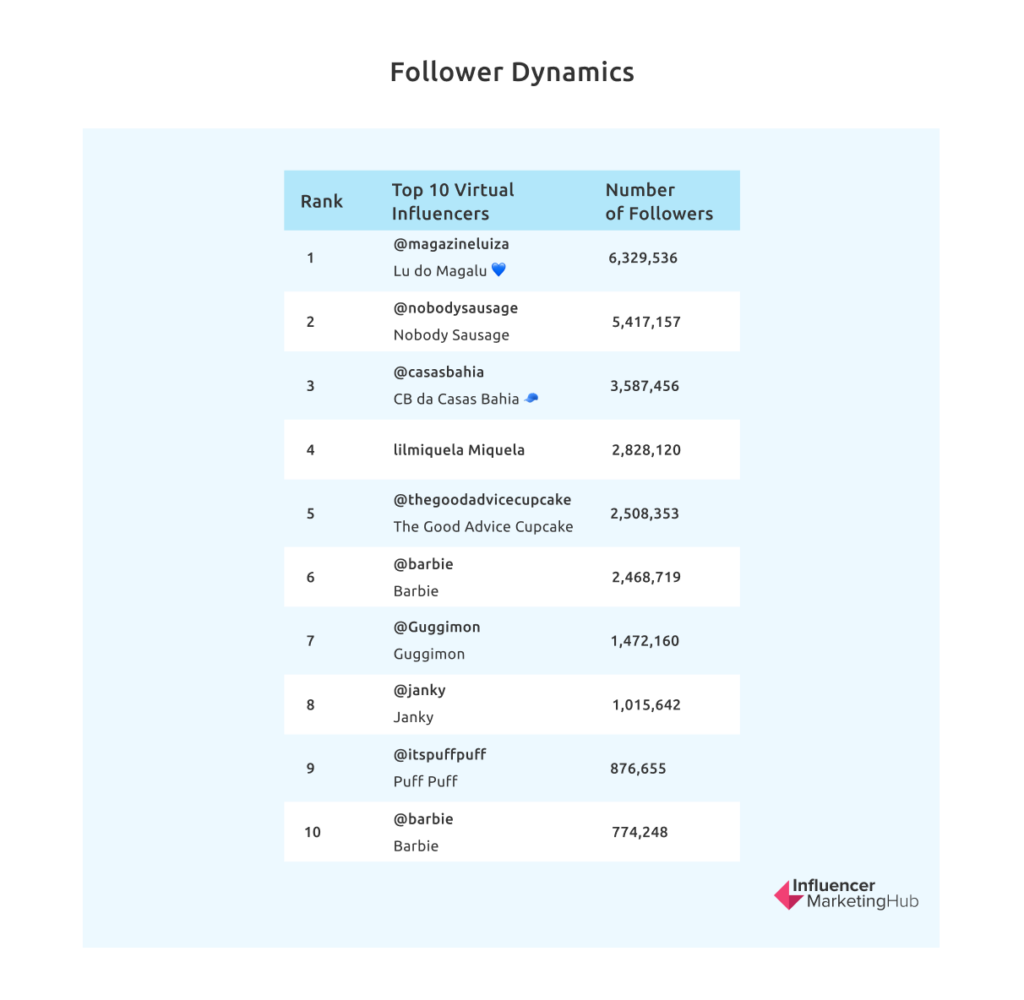
Virtual influencers, such as ‘Lu do Magalu ?’ from ‘magazineluiza’, have demonstrated significant impact within the digital community. With over 6.3 million followers, ‘Lu do Magalu ?’ stands as the most followed virtual influencer, underlining the considerable influence that AI entities can exert in engaging audiences.
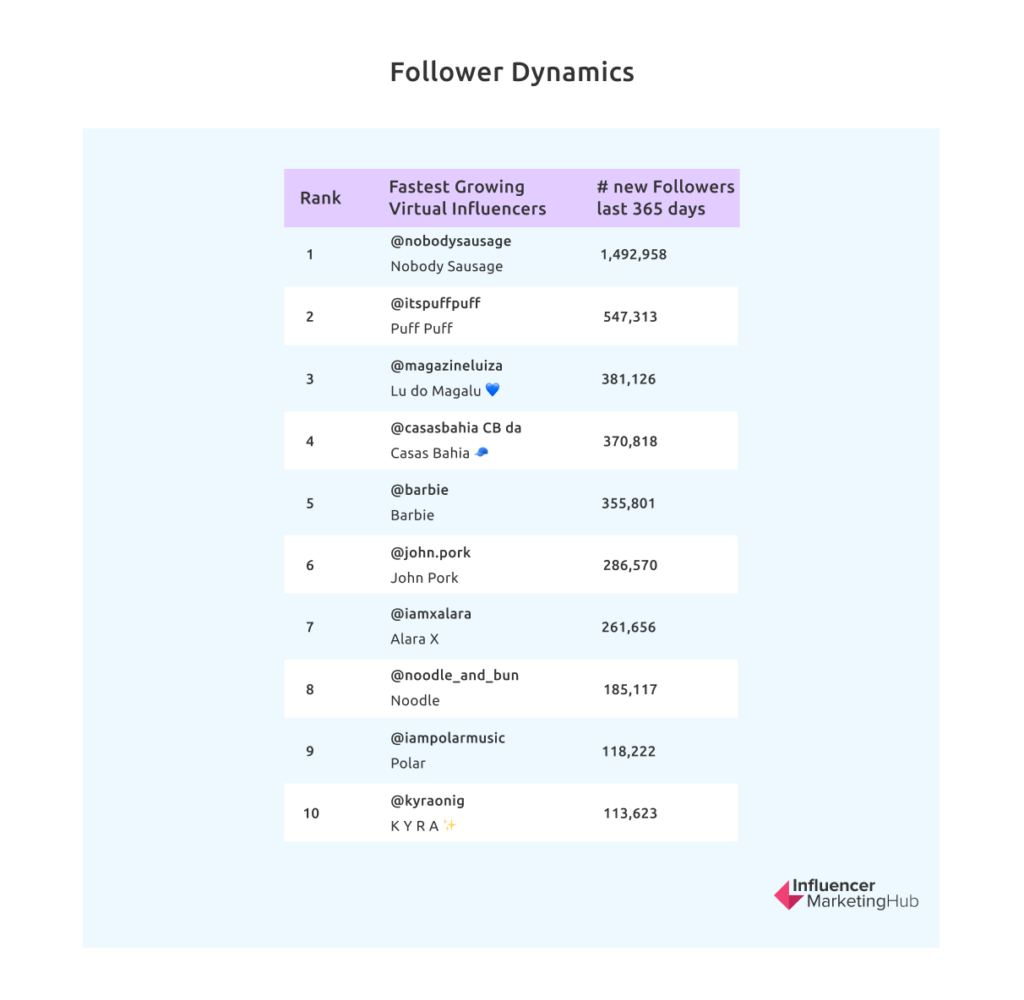
Another prominent example of this growing trend is ‘Nobody Sausage,’ the fastest-growing virtual influencer. A noteworthy part of ‘Nobody Sausage’s’ rise is its recent partnership with the renowned fashion brand, Hugo Boss. This association was a strategic move by Hugo Boss to engage with a younger demographic and bolster its global brand recognition as part of their Spring/Summer 2022 campaigns, #HowDoYouHUGO and #BeYourOwnBoss. This collaboration demonstrates how brands are leveraging the appeal and influence of AI influencers to reach and resonate with younger, digital-native consumers. This indicates an increasing acceptance and intrigue surrounding such unique virtual personas, highlighting their potential to disrupt traditional influencer dynamics.

Source: nobodysausage.com
Engagement and Audience Demographics
Interestingly, despite their artificial nature, virtual influencers outperform human influencers in average engagement rates – 2.84% compared to 1.72%. This suggests that AI influencers are successful in creating engaging content and fostering interaction among their followers.
A closer look at audience demographics reveals that virtual influencers draw a significant percentage of female audiences (65.5%) and younger audiences aged 13-17 (11.6%), indicating a particular resonance with these demographic groups.
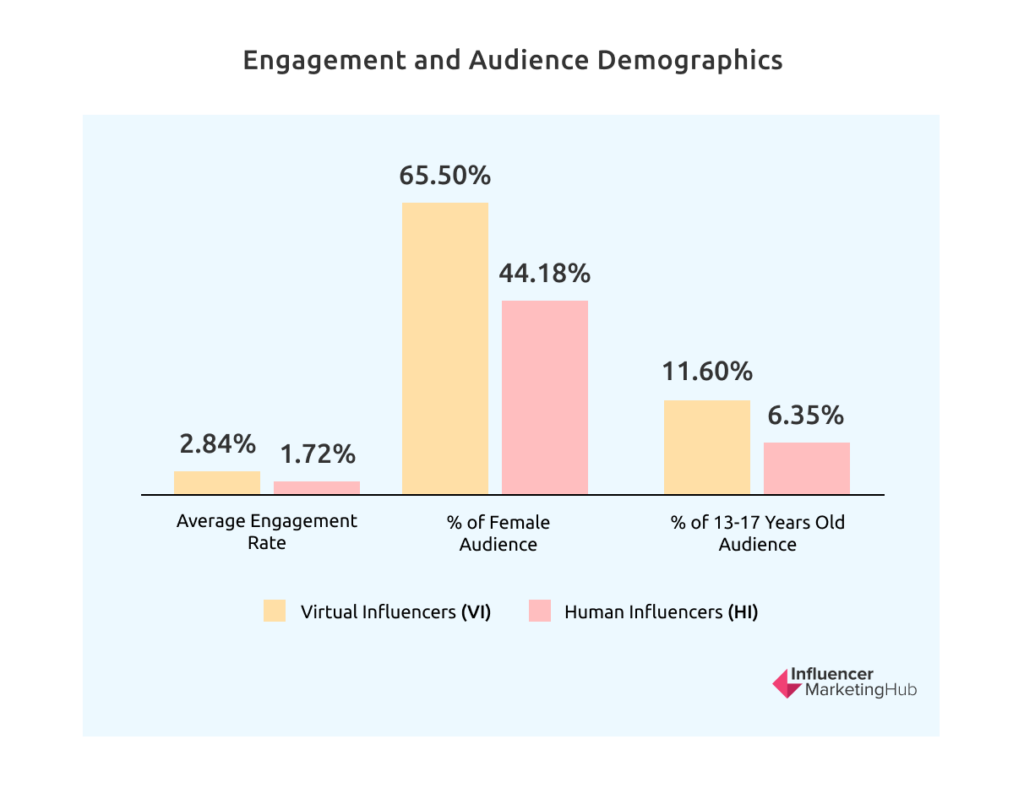
Geographic Presence
In terms of geographic distribution, the United States is home to the largest number of virtual influencers, leading the pack in this burgeoning market. However, Japan, the United Kingdom, Brazil, and South Korea also showcase a considerable presence, indicating the global appeal and reach of AI influencers.
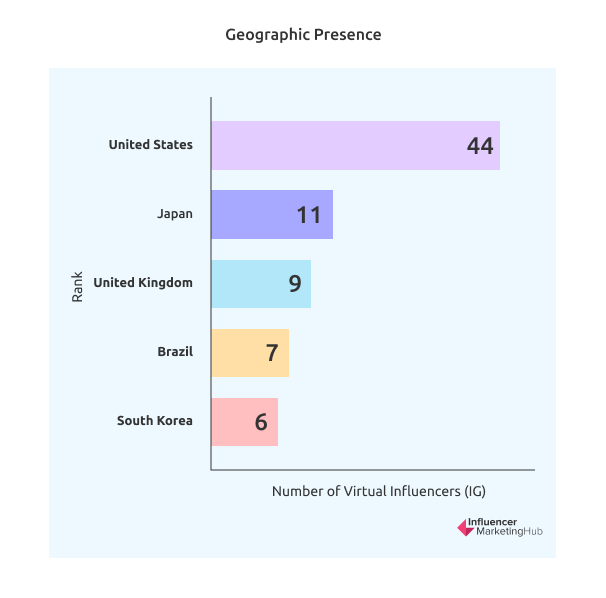
Content Preferences
When analyzing content distribution, it is notable that Reels (short-form videos on Instagram) constitute the largest share of posts from virtual influencers, followed by traditional posts and carousels. This trend suggests that video content, particularly shorter, more digestible formats, may be more effective in engaging audiences within the realm of AI influencers.
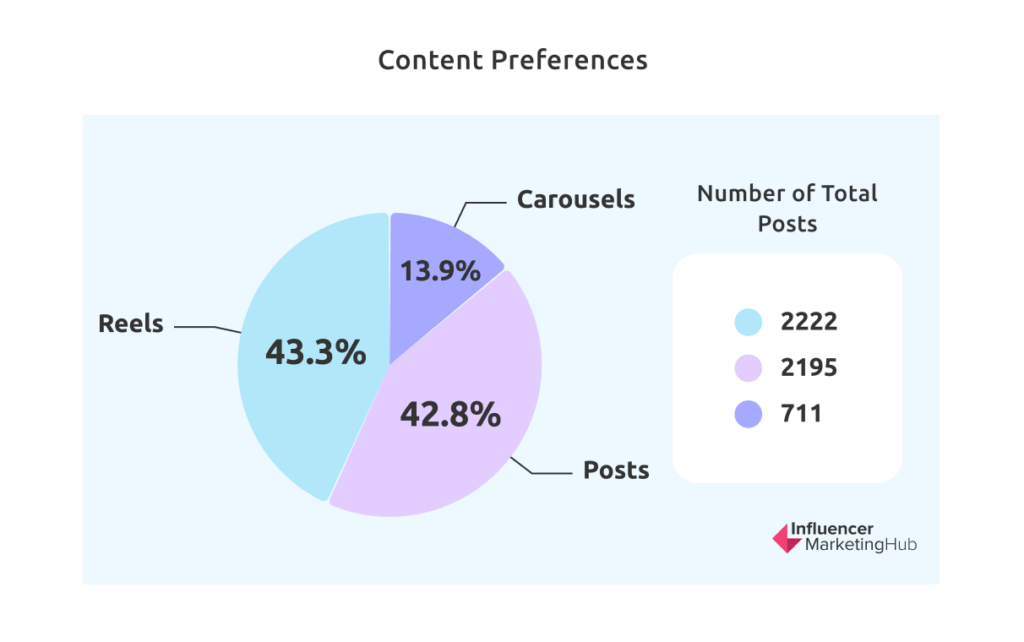
Investment in AI Influencers
AI influencers are another intriguing facet of this technological revolution. Several companies are dedicated to creating these ‘synthetic’ influencers and have managed to attract significant investments.
Superplastic, a pioneer in the creation of synthetic influencers, recently raised $20 million in a funding round led by Amazon, with an intriguing plan to branch out into TV shows. Brud, the company behind the popular virtual celebrity Lil Miquela, amassed an impressive total of $131 million in funding.
Moreover, Xmov, an emerging player based in Shanghai, has multiple digital influencer IPs under its belt. With the ambitious goal of building a ‘virtual world infrastructure,’ Xmov has raised $147.4 million over four rounds, with notable investors such as Sequoia China and SoftBank backing it.
The considerable investment in these AI influencers underlines their rising popularity and the tremendous potential they hold for reshaping the influencer marketing landscape.
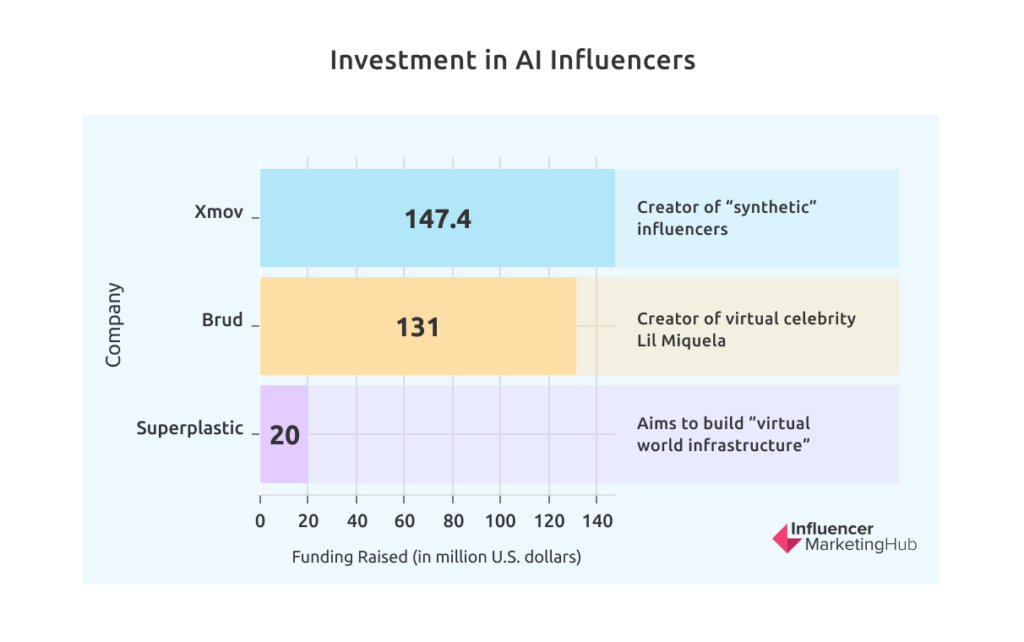
This graph underscores the significant investment being made in AI influencers, highlighting their growing importance in the influencer marketing industry. These figures indicate a trend of increasing financial support for innovations at the intersection of AI and influencer marketing.
Impact of AI Influencers on Consumer Perceptions
Building on the insights around the funding and development of AI influencers, let’s explore their impact in comparison to human influencers. The insights gathered from a riveting study titled “Unreal influence: leveraging AI in influencer marketing” published in the prestigious European Journal of Marketing in February 2022, are truly intriguing.
Before diving into the specifics, let’s understand why we need to focus on certain parameters. Trustworthiness measures the credibility of the influencer in the eyes of the consumer, a key factor in influencing purchasing decisions. The ‘Intention to Follow’ indicates the consumer’s interest and willingness to receive continued updates from the influencer, representing consumer engagement. ‘Word-of-Mouth (WOM) Intentions’ gauges the likelihood of consumers sharing the influencer’s content, a major driver for organic growth and reach. Lastly, ‘Social-Psychological Distance’ reflects the perceived closeness or relatability between the consumer and the influencer, which can impact the influence the latter has over the former.
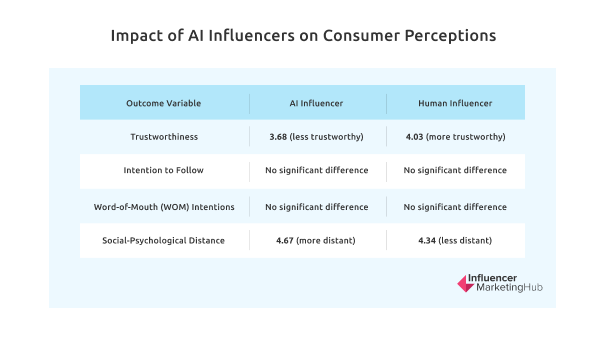
In addition to the differences in perceived trustworthiness and social-psychological distance, the study identified significant mediation effects. Social-psychological distance significantly mediated the effects of influencer type on trust, intention to follow, and WOM intentions. Here’s how that played out:
Contrary to expectations, the study found that a consumer’s need for uniqueness did not significantly moderate the mediated relationship between influencer type, social distance, and dependent variables such as source trust, intention to follow, and WOM intention.
While AI influencers were perceived as less trustworthy and more socially distant compared to their human counterparts, they were equally effective in generating intentions to follow and WOM intentions. This nuanced understanding can inform the strategic integration of AI influencers in marketing campaigns, illuminating their potential roles and implications in the influencer marketing landscape.
AI Influencers and Consumer Purchase Intentions
Building on the discussion of the comparative impact of AI and human influencers on consumer perceptions and behaviors, another essential metric is purchase intentions. This measure is vital as it signals the prospective influence an influencer has in terms of converting endorsements into tangible sales.
A recent study by Rudeloff, asked participants to consider their likelihood of purchasing products endorsed by the influencer, assuming those products were relevant to their interests.
The responses showed that those interacting with Social Media Influencers (SMI) were more likely to imagine making a purchase based on the influencer’s recommendation. This group represented 31% of positive responses, compared to only 20% from those interacting with Virtual Influencers (VI). Nevertheless, a significant portion of the VI group, 31%, were neutral towards the idea. Interestingly, the SMI group was more likely to indicate a low likelihood of purchasing, with 27% giving a rating of 1, compared to the VI group’s 21%.
Rating of Purchase Intent
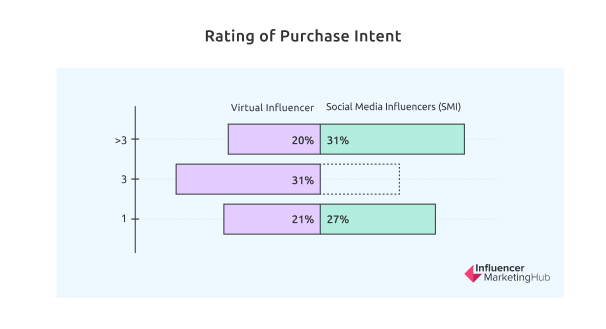
The analysis reveals that there’s no substantial difference between the purchase intentions of consumers interacting with VI and those interacting with SMI. This suggests that both types of influencers have roughly similar potential to drive purchases.
However, it’s worth noting that purchase intentions were overall rated relatively low in both groups. This indicates that there’s room for improvement for all influencers, human or AI, in nurturing stronger consumer intent to purchase. While the average scores for VI were slightly lower than those for SMI, the differences were not substantial enough to undermine the value of AI influencers. As the influencer marketing landscape continues to evolve, brands must keep exploring how to better utilize both AI and human influencers to nurture purchase intent and deliver effective marketing outcomes.
Factors Impacting Purchase Intent
It’s important to note that Rudeloff’s research does not appear to consider the influence of other variables such as product-endorser fit, which Kim and Park highlighted as a crucial factor in their study on Virtual influencers’ attractiveness effect on purchase intention. They found that the attractiveness of virtual influencers can stimulate consumers’ desire to imitate (mimetic desire) and foster an emotional connection with the brand (brand attachment), which in turn leads to a greater intention to purchase. Their findings emphasize the need for a good fit between the product and the influencer, in determining the effectiveness of advertisements.
An interesting case to consider here is the campaign for Netflix’s premier of the Red Notice movie. An AI influencer, Nobody Sausage, was invited to recreate the movie trailer. The results were striking – the animated, recreated trailers engaged viewers 62% more and were watched 1.53 times longer than the conventional trailer. This demonstrates the potential of an effective product-influencer fit in a real-world setting.
The omission of product-endorser fit in Rudeloff’s study could introduce a potential bias as it neglects a significant factor that can influence purchase intentions. This may partially explain the relatively low purchase intentions observed in both SMI and VI groups. Therefore, brands looking to enhance the effectiveness of influencer marketing should consider the influencer’s alignment with the product and their potential to stimulate mimetic desire and strong brand attachment among consumers. Integrating these considerations may lead to a more nuanced understanding of the effectiveness of different types of influencers, thereby better informing marketing strategies in the evolving influencer landscape.
Exploring Product-Endorser Fit: A Case Study on Virtual Influencers
To further emphasize the importance of product-endorser fit, let’s consider a case study from January 2023 that explored the effectiveness of virtual influencers based on the nature of the product being endorsed.
In this study, different groups of German women were shown ads featuring either a virtual influencer (Lil Miquela, a popular virtual influencer character) or a human influencer (Emily Bador), endorsing a range of products from cosmetics to technology. The products included a Lancôme cosmetics ad and ads for a Samsung speaker or a Calvin Klein cream.
The findings revealed an intriguing pattern that underscores the importance of the product-endorser fit. The women found the ad featuring the human influencer to be 22% more likable, but rated the ad with the virtual influencer as 11.2% more innovative. Furthermore, when considering their likelihood to purchase, they were more inclined to buy the speaker when it was paired with the virtual influencer, while they were more likely to buy the cream when it was paired with the human influencer.
This case study supports the argument that there’s no one-size-fits-all approach to influencer marketing. The effectiveness of virtual influencers, as compared to human influencers, can significantly vary depending on the product they’re endorsing. In this instance, a tech-related product benefited from the perceived innovation associated with a virtual influencer, whereas a product related to the human body seemed more appealing when endorsed by a human influencer.
Interestingly, our survey findings align with this case study’s results. When asked about how respondents foresee advancements in AI technologies shaping the future of AI influencers, a substantial majority were positive about this evolving intersection of technology and marketing. As many as 40.6 believed that such advancements will revolutionize the industry, while 25.1% envisioned significant improvements.
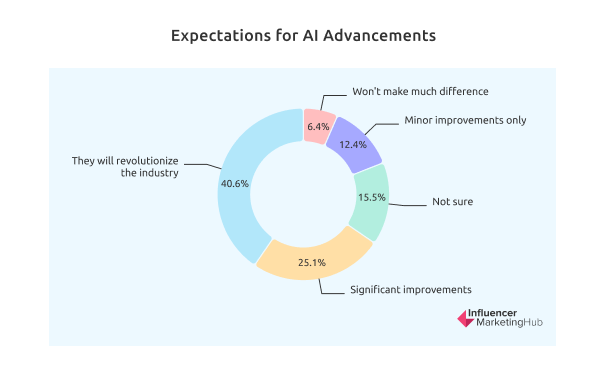
This reinforces the case study’s findings, suggesting that the increasingly innovative nature of AI influencers can be leveraged for products that are tech-related or innovative in nature. On the other hand, for products more closely related to the human body or personal experiences, human influencers may still hold sway, as they can bring a level of relatability and authenticity that resonates more deeply with audiences. The future of influencer marketing, therefore, is likely to involve a careful, strategic blend of human and AI influencers, selected based on the specific product and the target audience.
Authenticity, Product-Influencer Fit, and Endorsement Quality: Core Considerations in AI Influencer Marketing
As we describe previously, recent studies emphasize the pivotal role of product-endorser fit and the attractiveness of AI influencers in influencing consumers’ purchase intent. This theoretical underpinning is further strengthened by our recent survey data, which sheds light on the key factors that significantly impact consumers’ purchase intent based on an AI influencer’s endorsement.
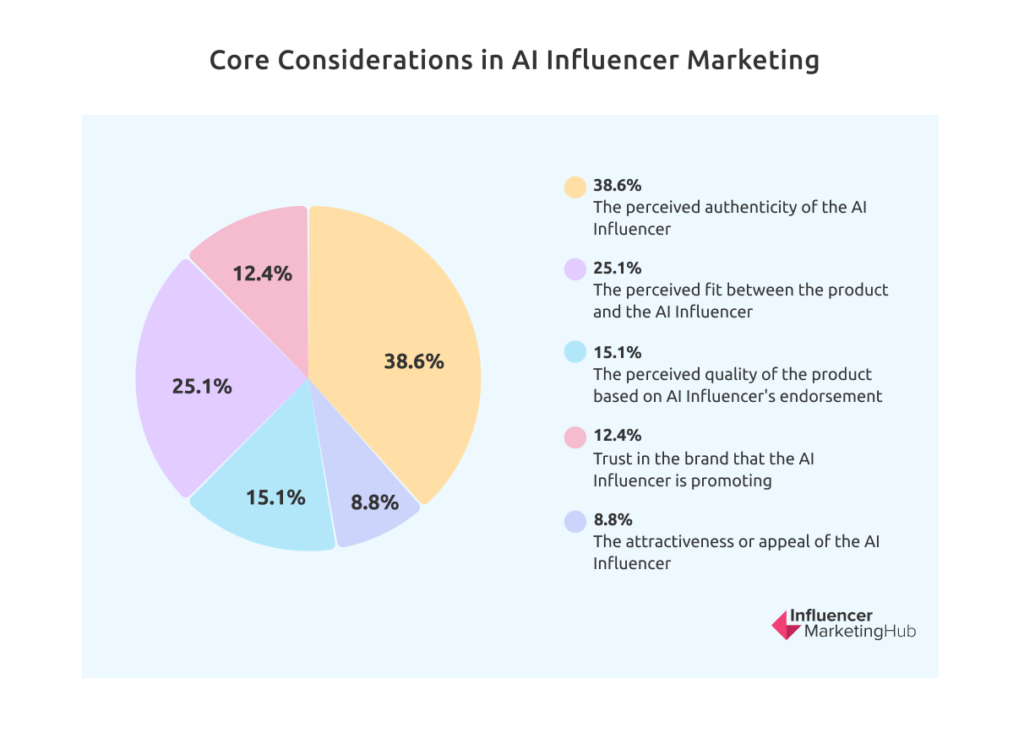
Interestingly, the perceived authenticity of the AI influencer emerged as the most significant factor impacting purchase intent, with 38.6% of respondents indicating its importance. This finding resonates with the notion that authenticity, often associated with human influencers, can also be a decisive factor when AI influencers are involved. It underscores the need for AI influencers to convey a sense of genuineness and integrity, aligning with Kim and Park’s research which emphasizes the role of emotional connection in fostering purchase intent.
The survey data also clearly reaffirms the importance of product-endorser fit, which was highlighted by 25.1% respondents as a crucial determinant of their purchase intent. This aligns seamlessly with the case study findings, further underscoring the need for a strategic match between the product and the influencer – whether human or AI.
While trust in the brand being promoted and the perceived quality of the product based on the AI influencer’s endorsement were highlighted by a smaller percentage of respondents, these factors nonetheless provide valuable insights into consumer behavior and decision-making.
Interestingly, the attractiveness or appeal of the AI influencer was considered significantly impactful by only 8.8% of respondents. This somewhat contrasts with Kim and Park’s findings, suggesting that while attractiveness can stimulate mimetic desire and brand attachment, other factors such as authenticity and product-influencer fit might be more influential in driving purchase dec.
AI Influencers Versatility Level
AI Influencers Versatility Level and Impact on Future Industries
AI influencers offer an unparalleled level of versatility that sets them apart in the world of influencer marketing. The ability of these digital entities to seamlessly adapt to diverse roles and scenarios across multiple sectors – from advertising to entertainment and education – is a core strength that has fueled their rise.
Survey findings lend weight to this perspective, offering fascinating insights into how industry professionals view AI influencers’ adaptability. When asked to rate AI influencers’ versatility compared to human influencers on a scale of 1 to 5 (where 1 = much less versatile and 5 = much more versatile), responses were evenly distributed across the spectrum.
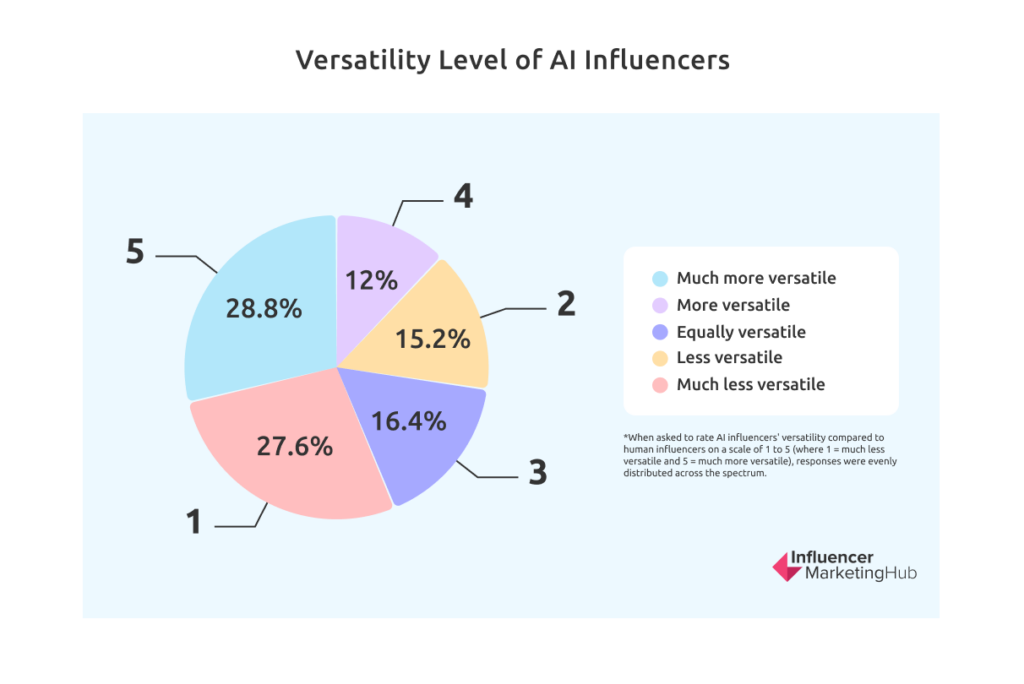
While a significant proportion, 28.8% (72 out of 250), saw AI influencers as much more versatile than their human counterparts, an almost equal number, 27.6% (69 respondents), considered them to be much less so. This dichotomy suggests that while AI influencers’ versatility is recognized by many, it’s not universally accepted.
Perhaps even more compelling is the belief in the transformative potential of AI influencers’ adaptability. A substantial 52.4% (131 out of 250) respondents strongly believe that this versatility will significantly impact the future of various industries, including marketing and entertainment. An additional 27.6% (69 respondents) agreed with this, but to a lesser extent.
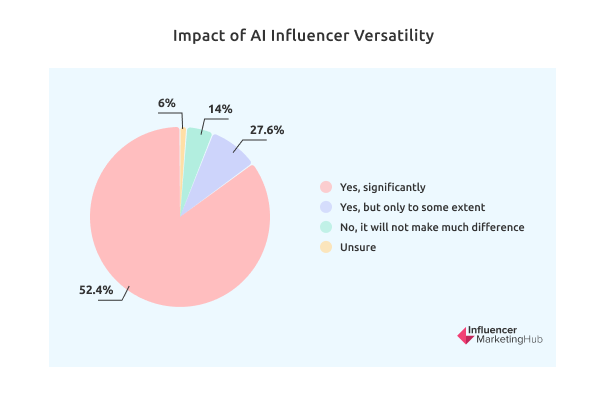
This belief in AI influencers’ transformative potential underscores their perceived value, reflecting a growing recognition of their multifaceted adaptability and role-shifting capabilities as pivotal in shaping the future of several industries. The inherent flexibility of AI influencers, alongside rapid technological advancements, empowers them to mold their persona and messaging to align with diverse brand narratives and target audiences, thereby offering a unique, customizable approach to influencer marketing.
In essence, AI influencers represent a bold new frontier in influencer marketing, replete with vast untapped potential. As they continue to evolve and mature, their versatility will likely become an increasingly central facet of their appeal and efficacy, reshaping the marketing landscape in ways we are just beginning to grasp.
Part 2 – Conclusion
The evolution of AI influencers has undeniably signaled a new era in marketing. These entities, crafted by complex algorithms, are not only winning over the attention of consumers but also becoming trusted voices that can influence purchase decisions. With nearly 60% of industry professionals already leveraging these novel influencers in their campaigns, the landscape of marketing is undeniably being reshaped. However, the innovation of AI influencers is not without its challenges and potentials. Approximately 40% of industry professionals remain on the sidelines, either yet to adopt or planning future integration of AI influencers in their marketing strategies. The key to converting this significant segment may lie in addressing the issues of trust and authenticity — core factors that influence consumer behavior and shape the effectiveness of influencer marketing. A compelling 49.3% of surveyed professionals view the effectiveness of AI influencers positively. Yet, neutrality and skepticism exist, with 28% maintaining a neutral perspective, and 10% expressing somewhat or very negative views. This hints towards a need for greater transparency, credibility, and genuine connection in the AI influencer space. AI influencers, though synthetic in creation, are expected to exude the authenticity that resonates with consumers. It’s thought-provoking to consider how the AI influencer landscape might evolve to meet these demands. Will we see AI influencers that can mirror human influencers in eliciting emotional connections? Or will we witness a whole new paradigm of influencer marketing, redefined by the unique attributes of AI? As the marketing industry continues to navigate these questions and grapple with the blend of technology and influence, one thing is clear — AI influencers represent an exciting, complex frontier that is far from fully explored. Their rise offers vast potential for brands willing to innovate, experiment, and pioneer in this emerging space. As with any frontier, those who are bold, flexible, and visionary stand to reap the greatest rewards.
About the Author
![]()
Writer
Djanan Kasumovic, a dynamic force in digital marketing, leads as the Head of Growth at Influencer Marketing Hub. His distinguished career includes roles at high-profile companies like SnappCar, a leader in European car sharing, Travelbird, Kids Luxury Group and B&S. Djanan has been at the forefront of innovative digital marketing processes, mastering areas such as AI content production, AI marketing, and AI influencer marketing, establishing himself as a pioneer in these fields.

